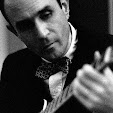The MIT Chapel, design by Eero Saarinen 1953-1956, photo by editor 2013
Eero Saarinen, 1950
Saarinen at mid-century had a string of notable achievements and was a known quantity within the design community. His collaboration with Charles Eames resulted in recognition by the MOMA in New York City as well as their participation in the Case Study House program in California (Number 9 to be exact). Eero had spent a good portion of the 1940s working in his father's architecture firm but after the death of the elder Saarinen in July of 1950, the younger launched a shop of his own. At just 85 years old in that same year, MIT was something of a young university - particular compared to its many esteemed and much longer in the tooth neighbors. In some ways, it lacked the traditions that a school such as Harvard had by that time, which may account for it's more forward-thinking artistic engagements.
Interior, The MIT Chapel, photo by editor 2013
Podium sculpture, Harry Bertoia, The MIT Chapel, photo by editor 2013
The resulting building remains as stunning today as I expect it was on it's dedication day. Saarinen created a haven: a place of remarkable peace and tranquility. The brick, wood, and marble evokes the pre-Christian world refashioned into something modern yet timeless. His use of light - both natural and artificial - is masterful. The final touches are both contributions from other artists. Harry Bertoia, who like Eames had first met Eero at Cranbrook University, provided the metal sculpture which descends from the ceiling to the base of the podium/altar. Other writers have focused on the speculative literal meaning of the piece, but it is simply a beautiful accent that deflects the incoming light in a hundred different direction. Interpret it as you wish. Theodore Roszak designed the abstract bell tower or spire which was added to the building in 1956.
The MIT Chapel is a singular structure: devoid of any denomination, yet vibrantly spiritual and a shrine to solace. I would expect - if not hope - that its chairs have been full these past couple of weeks.
















4 comments:
The days when modernism quite literally reached for the stars, though I normally feel there is a inherent fault-line in the relationship between the world of faith and the rational world of science and progress which modernism aligns itself with. It's startling when the two successfully interconnect, as is clearly the case here.
I would tend to agree with you JP. There are plenty examples here in the States of less successful partnerships. It is quite odd how prominent the "modernist place of worship" is throughout this country though. Meet in me Anywheresville, U.S.A. and there is a very good chance we can find a meeting place of organized religion that was built in the 1950s-1960s incorporating very progressive architectural ideas.
We have a number in the UK too, perhaps most notably the Roman Catholic Cathedral in my home town Liverpool - http://en.wikipedia.org/wiki/Liverpool_Metropolitan_Cathedral. When first constructed it was universally mocked, but, as with much 60s modernism, it has come to be loved.
And speaking from my own Roman Catholic upbringing, the design aesthetic often extended into not only the internal design of these places but some of the basic tools of the rituals. I remember being fascinated as a young child by this one particular extremely modern cross. It seemed more in line with what you would expect on a spaceship rather than a Middle Eastern desert.
Post a Comment